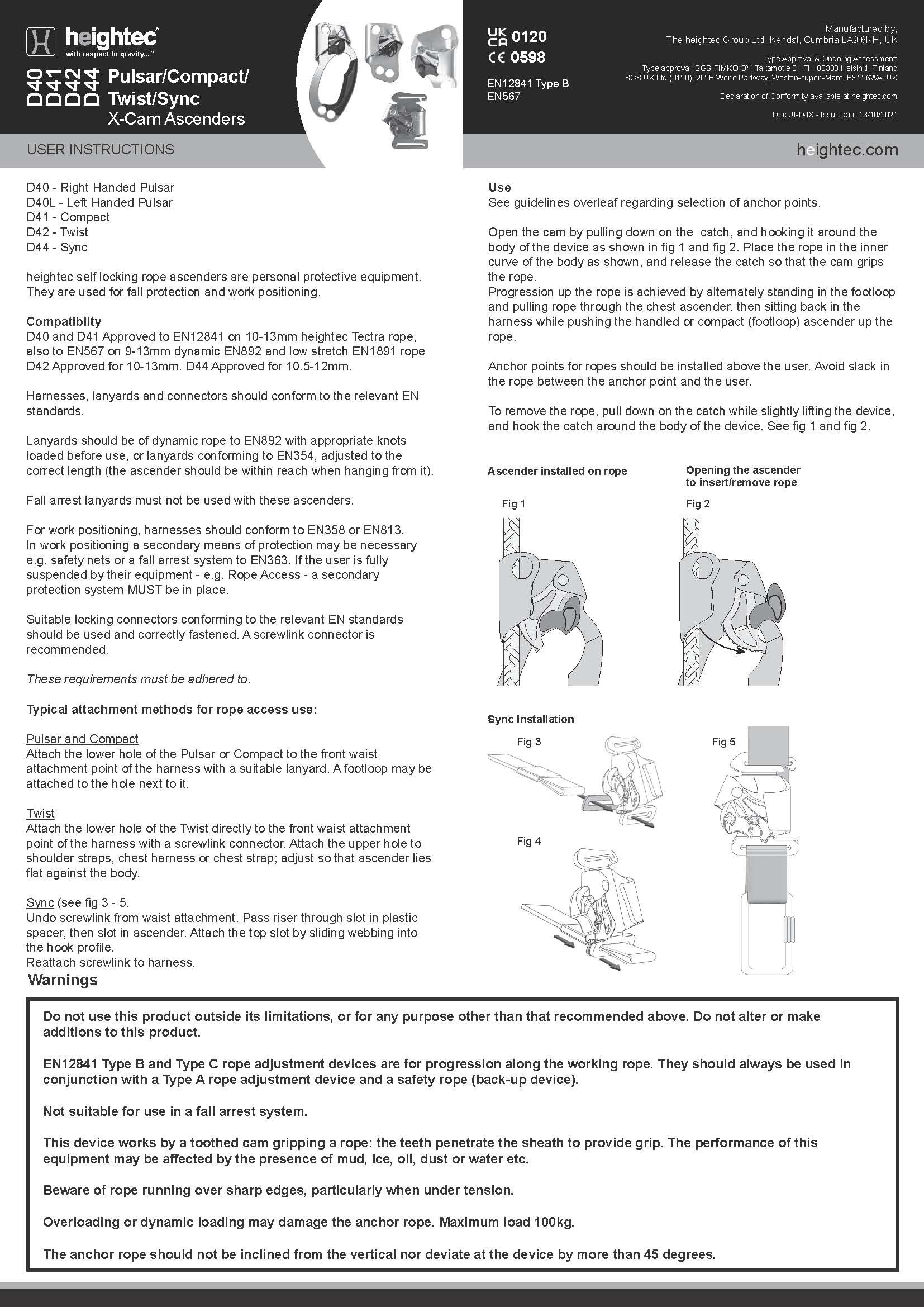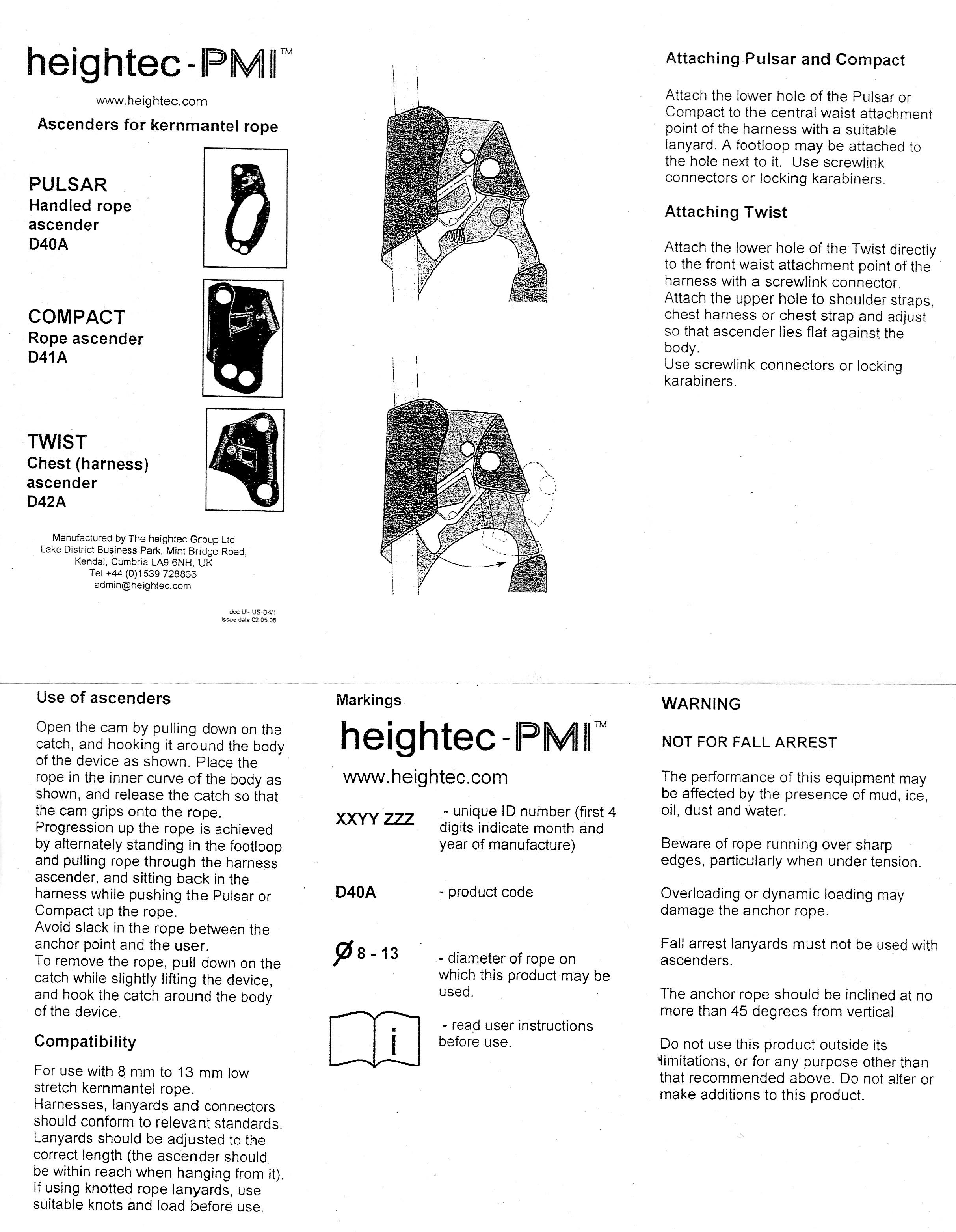Overview
Heightec once marked some of their products with the "heightec-PMI" brand for sale by PMI in the U.S.A.
[ Top
| D41, v. B
| D41A, v. A
| D41A, v. B
| D44
| Return to E.C. Ascenders
]
heightec D41 Compact Basic Ascender,
Version A
(#2960)
Technical Details
I acquired my heightec Compact Basic D41 from Kyle Evans in 2020.
This heightec D41 is 112 mm. tall, 71 mm. wide, 27 mm. thick, and weighs 169 g.
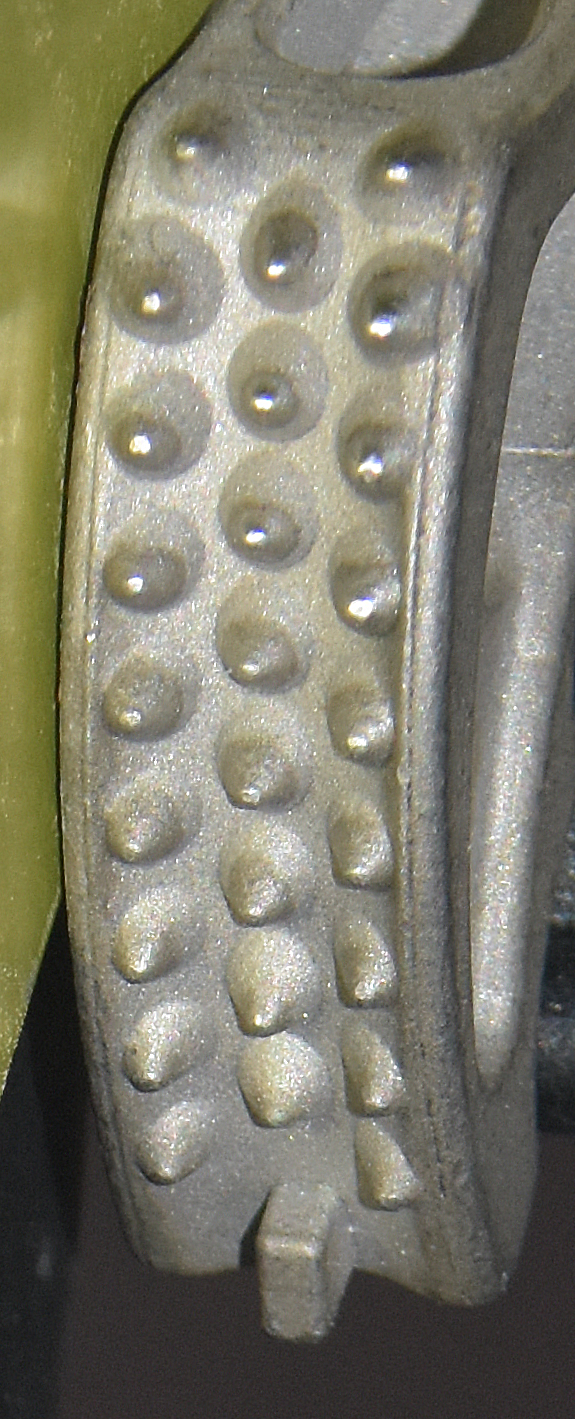 The D41A is right-handed. The shell is a subrectangular green anodized shape
bent from 3.9 mm. aluminum sheet. The rope channel is formed
by bending the left side of the ascender into a U. The rope
channel is 17 mm. wide. The main sling attachment
point is 1 15.2 mm. hole located below the cam and to the
right of the rope channel. A second lower attachment point of
the same size lies right and slightly below the first. There is
an upper attachment point above the cam, passing through both
sides of the rope channel. The upper opening is 18.1 mm.
high and 15.0 mm. wide. The right side of the shell is bent
on an inclined axis to form another U. A hole drilled through
both sides of the U accepts a solid rivet. The cam and cam
spring are mounted on this rivet. The head of the rivet is on
the front of the shell. The pivot is centered 47 mm. from
the inside of the rope groove. There is a 4.9 mm. high, 12.5 mm.
diameter cam stop pin riveted to the shell.
The D41A is right-handed. The shell is a subrectangular green anodized shape
bent from 3.9 mm. aluminum sheet. The rope channel is formed
by bending the left side of the ascender into a U. The rope
channel is 17 mm. wide. The main sling attachment
point is 1 15.2 mm. hole located below the cam and to the
right of the rope channel. A second lower attachment point of
the same size lies right and slightly below the first. There is
an upper attachment point above the cam, passing through both
sides of the rope channel. The upper opening is 18.1 mm.
high and 15.0 mm. wide. The right side of the shell is bent
on an inclined axis to form another U. A hole drilled through
both sides of the U accepts a solid rivet. The cam and cam
spring are mounted on this rivet. The head of the rivet is on
the front of the shell. The pivot is centered 47 mm. from
the inside of the rope groove. There is a 4.9 mm. high, 12.5 mm.
diameter cam stop pin riveted to the shell.
The cam is a plated skeletonized steel casting. The cam radius increases from 33 to 53 mm. over an angle of 45°, giving a 31° cam angle. The cam has number
of small conical teeth, all of which have their axes approximately
perpendicular to the cam face. The tooth pattern is (2)(1.2)^8(B).
The B stands for a small bar. A plastic spring-loaded manual safety is
mounted on an axle riveted to the bottom center of the
cam. The normal action of the spring holds the safety against
the cam.When the cam is opened, the
shell interferes with the safety, thus preventing cam opening.
At full open the safety can be released and the spring will hold
the tab against the back of the shell, locking the cam open.
The rear of the ascender is printed with "D41,"
"Compact Ascender," the heightec logo," "heightec," a standing man icon, "↑," a book-with-an-"i" icon, "CE0120," "EN567:1997," "EN12841B:2006," "Ø9-13 mm," "125kg," "21714,"
and "1554."
|
 |
Warning:
The weight ("125kg") printed on the shell can easily be
less than the weight of a fully loaded caver. |
 |
|
The heightec is solidly made. All sharp edges have been
removed. It is slightly heavier than average, but it has two good
tie-in holes at the base for those who need them. The attachment
points are simply holes in the shell, and although rounded they
should have been beveled more; even so, I would consider their
small radius too sharp for directly attaching rope slings. The
upper rope attachment hole is located very close to the main rope.
A carabiner through the upper attachment hole will probably drag
on the main line. Note that such a carabiner will prevent putting
the ascender on or off rope, so one’s climbing system must be
designed accordingly.
The cam is different than the one on the D41A and D44, but the change in shape appears to be more aesthetic than functional. The cam teeth are rather large and dull, but they seem to work well enough.
The cam stop is larger than the ones on the D41A and D44, and it holds the cam face about 4.5 mm. from the inner side of the rope channel.
The safety is awkward to use with one hand.
[ Top
| D41, v. A
| D41A, v. A
| D41A, v. B
| D44
| Return to E.C. Ascenders
]
heightec D41 Compact Basic Ascender,
Version B
(#3502)
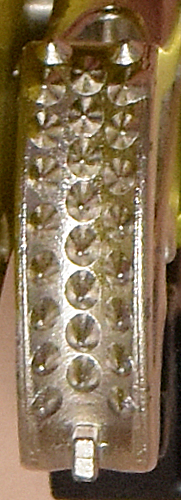 Technical Details
Technical Details
I acquired my heightec Compact Basic D41, Version B from heightec in 2022.
This D41 is 111 mm. tall, 61 mm. wide, 26 mm. thick, and weighs 165 g.
This version replaces the riveted pin cam stop with a stamped cam stop.
The cam is a plated skeletonized steel casting. The cam radius increases from 33 to 53 mm. over an angle of 45°, giving a 31° cam angle. The cam has number
of small conical teeth, all of which have their axes approximately
perpendicular to the cam face. The tooth pattern is (2)(1.2)^8(B).
The B stands for a small bar. A plastic spring-loaded manual safety is
mounted on an axle riveted to the bottom center of the
cam. The normal action of the spring holds the safety against
the cam.When the cam is opened, the
shell interferes with the safety, thus preventing cam opening.
At full open the safety can be released and the spring will hold
the tab against the back of the shell, locking the cam open.
The rear of the ascender is printed with "D41,"
"Compact Ascender," the heightec logo," "heightec," a standing man icon, "↑," a book-with-an-"i" icon, "UKCA", "0120," "CE0598,""EN567:2013," "EN12841B:2006," "•Ø9-13 mm," "100kg," and "071221."
It is stamped with "D0248."
|
 |
Warning:
The weight ("100kg") printed on the shell can easily be
less than the weight of a fully loaded caver. |
 |
|
The new cam stop also it holds the cam face away from the inner side of the rope channel, but the distance to contact is minimal.
[ Top
| D41, v. A
| D41, v. B
| D41A, v. B
| D44
| Return to E.C. Ascenders
]
heightec-PMI D41A, Version A
(#254, 2126)
Technical Details
I acquired my heightec-PMI Compact D41A from On Rope 1
at the 2008 Old Timers’ Reunion. I acquired another in 2017 as part of Bob Thrun’s collection.
The D41A is right-handed.
This ascender is 113 mm. tall, 72 mm. wide, 27 mm.
thick, and weighs 164 g.
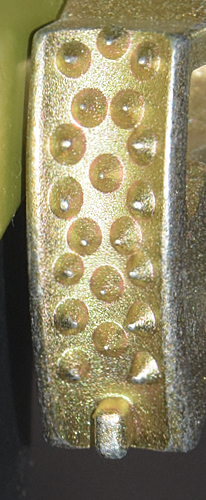 The ascender shell is a subrectangular green anodized shape
bent from 4.1 mm. aluminum sheet. The rope channel is formed
by bending the left side of the ascender into a U. The rope
channel is 16.5 mm. wide. The main sling attachment
point is 1 15.1 mm. hole located below the cam and to the
right of the rope channel. A second lower attachment point of
the same size lies right and slightly below the first. There is
an upper attachment point above the cam, passing through both
sides of the rope channel. The upper opening is 18.0 mm.
high and 14.9 mm. wide. The right side of the shell is bent
on an inclined axis to form another U. A hole drilled through
both sides of the U accepts a solid rivet. The cam and cam
spring are mounted on this rivet. The head of the rivet is on
the front of the shell. The pivot is centered 47 mm. from
the inside of the rope groove. There is a 4.9 mm. high, 7.9 mm.
diameter cam stop pin riveted to the shell.
The ascender shell is a subrectangular green anodized shape
bent from 4.1 mm. aluminum sheet. The rope channel is formed
by bending the left side of the ascender into a U. The rope
channel is 16.5 mm. wide. The main sling attachment
point is 1 15.1 mm. hole located below the cam and to the
right of the rope channel. A second lower attachment point of
the same size lies right and slightly below the first. There is
an upper attachment point above the cam, passing through both
sides of the rope channel. The upper opening is 18.0 mm.
high and 14.9 mm. wide. The right side of the shell is bent
on an inclined axis to form another U. A hole drilled through
both sides of the U accepts a solid rivet. The cam and cam
spring are mounted on this rivet. The head of the rivet is on
the front of the shell. The pivot is centered 47 mm. from
the inside of the rope groove. There is a 4.9 mm. high, 7.9 mm.
diameter cam stop pin riveted to the shell.
The cam is a plated skeletonized steel casting. The cam radius,
measured from the pivot, increases from 38 to 52 mm. over
an angle of 37°, giving a 26° cam angle. The cam has number
of small conical teeth, all of which have their axes approximately
perpendicular to the cam face. The tooth pattern is (1.2^3)^2(1.2)^2(B).
The B stands for a small bar. A spring-loaded manual safety is
mounted on an axle riveted to the bottom center of the
cam. The normal action of the spring holds the safety against
the cam. The safety has a 12.8 mm. tall, 6 mm. diameter
pin mounted on it for the fingers. When the cam is opened, the
shell interferes with the safety, thus preventing cam opening.
At full open the safety can be released and the spring will hold
the tab against the back of the shell, locking the cam open.
The rear of the ascender is printed with "D41A,"
a book-with-an-"i" icon, "Ø8-13," "0608 074,"
"heightec-PMI," and "www.heightec.com."
The heightec-PMI is solidly made. All sharp edges have been
removed. It is slightly heavier than average, but it has two good
tie-in holes at the base for those who need them. The attachment
points are simply holes in the shell, and although rounded they
should have been beveled more; even so, I would consider their
small radius too sharp for directly attaching rope slings. The
upper rope attachment hole is located very close to the main rope.
A carabiner through the upper attachment hole will probably drag
on the main line. Note that such a carabiner will prevent putting
the ascender on or off rope, so one’s climbing system must be
designed accordingly.
The safety is awkward to use with one hand (like the Petzl
Basic). The cam and its teeth are very well made. I'm not
sure what purpose the bar serves - several people have sent me
emails telling me that the analogous bars on the Lucky
AB-20 and VauDe AB-20 Bloquer keep
the cam from closing and touching the shell (so what?), but the
bar does not do touch the shell on the D41A. Perhaps it is there
to keep the ascender from gripping small cord??
[ Top
| D41, v. A
| D41, v. B
| D41A, v. A
| D44
| Return to E.C. Ascenders
]
heightec-PMI D41A, Version B
(#1528, 1966, 2127)
Technical Details
 I acquired my first heightec-PMI Compact D41A, Version B from On Rope 1 in 2009, a second from FRHAM Safety Products, Inc. in 2013, and another in 2017 as part of Bob Thrun’s collection.
I acquired my first heightec-PMI Compact D41A, Version B from On Rope 1 in 2009, a second from FRHAM Safety Products, Inc. in 2013, and another in 2017 as part of Bob Thrun’s collection.
The heightec-PMI Compact D41A, Version B is 112 mm. tall, 73 mm. wide, 26 mm. thick, and weighs 160 g. The shell and cam are the same as those on Version A, but the cam safety on Version B is molded from plastic.
The rear of the ascender is printed with "D41A,"
a book-with-an-"i" icon, "Ø8-13," "300909 106,"
"heightec-PMI," and "www.heightec.com."
The new safety is as awkward to use with one hand as the older one is.
[ Top
| D41, v. A
| D41, v. B
| D41A, v. A
| D41A, v. B
| Return to E.C. Ascenders
]
heightec-PMI Rescue Compact D41A /
D44 Rope Grab / D44A
(#255, 2128)
Confused by the name?
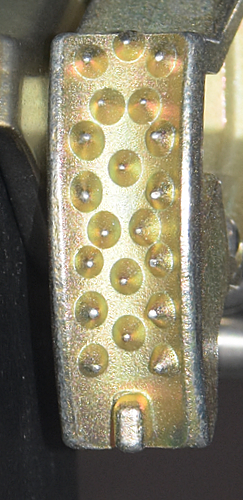 What should I call this? There are several obvious options,
as follows
What should I call this? There are several obvious options,
as follows
- The box that it came in calls it a "RESCUE COMPACT -
D44 ROPE GRAB" and has an upside-down picture of the device.
- The instruction sheet calls it a "RESCUE COMPACT Stainless
SteelRope [sic] ascender D41A and has a right-side-up picture
of the device. The instructions give instructions for use as
an ascender and as a device for hoisting casualties; but they
also say, "WARNING- NOT FOR FALL ARREST," which means
that this is NOT a rope grab.
- The device itself is marked "D44A."
- The 2008 PMI catalog, page 65 calls this a "RESCUE COMPACT"
and states that it is "slid down to the subject for a secure
connection in a variety of situations," indicating that
it is neither a rope grab nor an ascender.
Since the instructions warn me not to use this as a rope grab,
heightec-PMI has another device numbered D41A,
and that device is an ascender with an aluminum shell (shaped
somewhat differently), I'm going to use the number on the box
and call this one a D44 (assuming that an A stands for aluminum),
and call it an ascender.
Technical Details
I acquired my D44 from On Rope 1 at the 2008 Old Timers’
Reunion. I acquired another in 2017 as part of Bob Thrun’s collection.
This ascender is 113 mm. tall, 80 mm. wide, 25 mm.
thick, and weighs 300 g.
The D44 is right-handed. The ascender shell is subtriangular red anodized shape bent
from 2.9 mm. stainless steel sheet. The rope channel is formed
by bending the left side of the ascender into a U. The rope
channel is 15.8 mm. wide. The main sling attachment
point is a 14.9 mm. hole located below the cam and to the
right of the rope channel. A second lower attachment point of
the same size lies right and slightly below the first. The right
side of the shell is bent on an inclined axis to form another U.
A hole drilled through both sides of the U accepts a roll
rivet. The cam and cam spring are mounted on this rivet. The head
of the rivet is on the front of the shell. The pivot is centered
51 mm. from the inside of the rope channel. There is a 4.9 mm.
high, 7.9 mm. diameter cam stop pin riveted to the shell.
The cam is a plated skeletonized steel casting. The cam radius,
measured from the pivot, increases from 38 to 52 mm. over
an angle of 37°, giving a 26° cam angle. The cam has number
of small conical teeth, all of which have their axes approximately
perpendicular to the cam face. The tooth pattern is (1.2^3)^2(1.2)^2(B).
The B stands for a small bar. A spring-loaded manual safety is
mounted on an axle riveted to the bottom center of the
cam. The normal action of the spring holds the safety against
the cam. The safety has a 12.8 mm. tall, 6 mm. diameter
pin mounted on it for the fingers. When the cam is opened, the
shell interferes with the safety, thus preventing cam opening.
At full open the safety can be released and the spring will hold
the tab against the back of the shell, locking the cam open.
The rear of the ascender is etched with "heightec-PMI,"
"D44A," a book-with-an-"i" icon,
"O Ø" "10.5-13," and "0708."
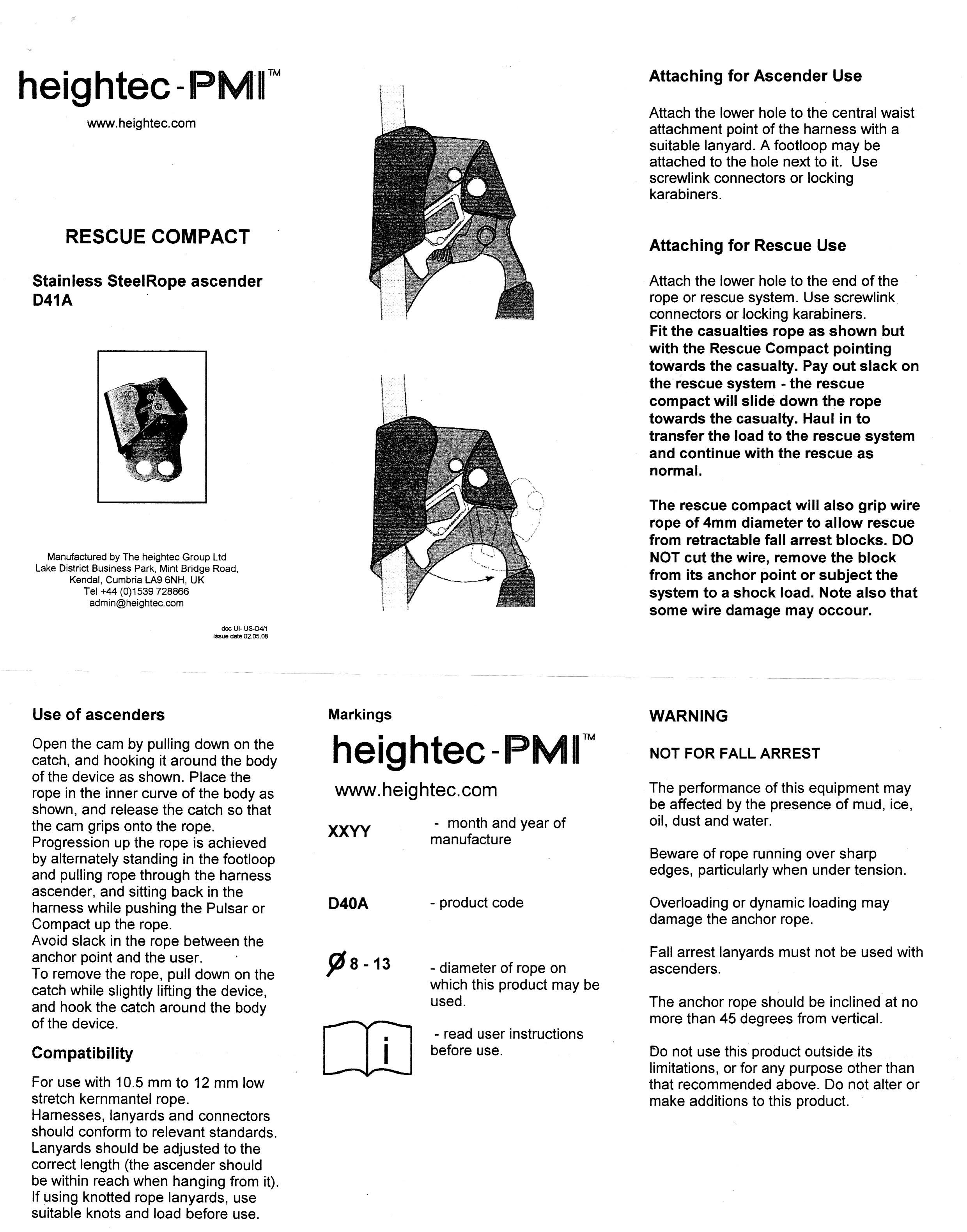 The D44 is similar to the heightec-PMI
Compact D41A, but there are some differences in the shell
shape (and material) and the shape of the cam safety. The larger
shell adds some unnecessary bulk, and the longer cam safety adds
some security to the hold-open feature (security means little
when it used is to prevent gripping) at the expense of
making the safety harder to operate.
The D44 is similar to the heightec-PMI
Compact D41A, but there are some differences in the shell
shape (and material) and the shape of the cam safety. The larger
shell adds some unnecessary bulk, and the longer cam safety adds
some security to the hold-open feature (security means little
when it used is to prevent gripping) at the expense of
making the safety harder to operate.
The heightec-PMI is solidly made. All sharp edges have been
removed. It is too heavy for regular caving or climbing use, but
the extra weight might allow it to be "slid down to the subject
for a secure connection in a variety of situations" as the
catalog suggests. Extra weight even might please the "bigger-is-better" crowd.
The attachment points are simply holes in the shell, and although
rounded they should have been beveled more; even so, I would consider
their small radius too sharp for directly attaching rope slings.
The cam and its teeth are very well made. I'm not sure what
purpose the bar serves - several people have sent me emails telling
me that the analogous bars on the Lucky AB-20
and VauDe AB-20 Bloquer keep the cam
from closing and touching the shell (so what?), but the bar does
not do touch the shell on the D41A. Perhaps it is there to keep
the ascender from gripping small cord??
[ Top
| D41, v. A
| D41, v. B
| D41A, v. A
| D41A, v. B
| D44
]



